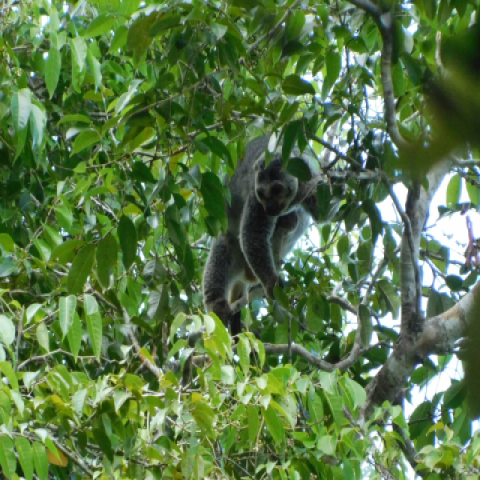Conservation Actions
Pongo abelii is strictly protected by Indonesian National Law No. 5/1990 on the Conservation of Natural Resources and Ecosystems, under which it is illegal to capture, injure, kill, own, keep, transport, or trade a Sumatran Orangutan. Sumatran Orangutans are also protected by international legislation, and listed on CITES Appendix I.Protection of large areas of primary forest below 1,500 m asl is needed to secure their long-term future. The species’ major stronghold is the Leuser Ecosystem – an area of 26,000 km² mostly contiguous forest that supports circa 95.0% of the Sumatran Orangutans remaining in the wild. Conservation of the Leuser Ecosystem was called for under Indonesian National Law No. 11/2006 concerning Governance in Aceh, and it was inaugurated by Presidential Decree in 1998. Designated a National Strategic Area for its environmental function, the Leuser Ecosystem must be fully recognized and its integrity ensured at all levels of spatial land-use planning. According to these laws, management of the Leuser Ecosystem does not exclude non-forest uses, but stresses the importance of sustainable management with conservation of natural resources as the primary goal.
Within the Leuser Ecosystem is the 9,000 km² Gunung Leuser National Park, also designated a Man and Biosphere Reserve and a part of the Tropical Rainforest Heritage of Sumatra World Heritage Cluster Site by UNESCO. The park alone, comprising mostly high mountains, supports only 25.3% of Sumatra’s Orangutans. Much of Sumatra’s dense lowland forest is outside the National Park’s boundaries, but is part of the larger Leuser Ecosystem. Also within the Leuser Ecosystem, but not a part of the World Heritage Cluster Site, is the 1,025 km² Singkil Swamps Wildlife Reserve. Outside the Leuser Ecosystem, no other large, formally-established conservation areas harbour this species.
Action Plan
Orangutan National Action Plan 2007-2017
Location Information
Pongo abelii is endemic to the island of Sumatra, Indonesia. It is restricted to the north of the island, with its southern limit being the Simpang Kanan River and tributaries on the west coast and the Asahan River on the east coast, and its northern limit coinciding primarily with the northern boundary of the Leuser Ecosystem in Aceh Province (Wich et al. 2003, 2008, 2016).Today the majority of Sumatran Orangutans (82.5%) are found in Aceh Province at the northernmost tip of the island. There are populations in North Sumatra Province but the largest of these, in the southern and eastern regions of the Leuser Ecosystem, straddles the border with Aceh. Despite a few smaller patches of forest south of the Leuser Ecosystem appearing to still host orangutan populations, only one entirely North Sumatran population is considered viable in the long term, namely the Pakpak Barat population (for precise locations, see Wich et al. 2008, 2016).
Sumatran Orangutan densities decline with increasing altitude and few, if any, reproducing populations are thought to reside in forests above 1,500 m asl (Wich et al. 2016).
Geographic Range
Extant
Indonesia
Population Information
The most recent population estimate for the Sumatran Orangutan is 13,846 individuals, in a total area of 16,775 km² of forest (Wich et al. 2016). Excluding populations of fewer than 250 individuals (i.e., considering only populations that are potentially viable over the long term) leaves just 13,587 individuals. The vast majority (i.e., 95.0%) occur in the Leuser Ecosystem, while other populations are found in the Sidiangkat and Pakpak. The 2016 estimate is higher than the previous estimate of around 6,600 individuals remaining (Wich et al. 2008), as it takes into account three factors: a) orangutans were found in greater numbers at higher altitudes than previously supposed (i.e., up to 1,500 m asl not just to 1,000 m asl), b) they were found to be more widely distributed in selectively-logged forests than previously assumed, and c) orangutans were found in some previously unsurveyed forest patches. The new estimate does not, therefore, reflect a real increase in Sumatran Orangutan numbers. On the contrary, it reflects only much improved survey techniques and coverage, and hence more accurate data. It is extremely important to note, therefore, that overall numbers continue to decline dramatically.Since Sumatran Orangutans have been found up to 1,500 m asl in many areas, there is probably better connectivity among subpopulations in the mountainous Leuser Ecosystem than was previously considered the case (Wich et al. 2008). Nevertheless, recent studies found genetic differentiation between subpopulations that is at least partially due to geographic barriers, such as rivers and high mountain ridges, even within the Leuser Ecosystem (Nater et al. 2013).
In addition to the wild populations, two entirely new Sumatran Orangutan populations are gradually being established via the reintroduction of confiscated illegal pets; one in and around the Bukit Tigapuluh National Park (Jambi and Riau provinces) and one in and around the Jantho Pine Forest Nature Reserve, in the far north of Aceh. To date, more than 260 individuals have been reintroduced. The goal of these efforts is to eventually establish new, genetically-viable, fully-reproducing and self-sustaining wild populations as a safety net against catastrophe elsewhere in the species’ range.
About 35.6% of the Sumatran Orangutan population is in protected areas (World Database Protected Areas recognized areas, i.e. excluding hutan lindung/protection forest; SOCP unpublished data), followed by 40.0% in hutan lindung/protection forest, 3.6% in limited production forest, 11.8% in production forest, and 8.9% in other use forest. Including the whole Leuser Ecosystem, which is on the list of Indonesia’s WDPAs: 98.5% of all Sumatran Orangutans are in PAs (incl. hutan lindung/protection forest) or 95.5% in all WDPA recognized areas (thus excluding hutan lindung/protection forest).
Threats
The Sumatran Orangutan's survival is seriously threatened by habitat loss and fragmentation (Wich et al. 2008, 2011, 2016). Forests continue to be cleared at the large and medium scale for oil-palm plantations that can each cover hundreds of square kilometres. On a smaller scale, logging for timber (both legal and illegal) remains a threat, as does the creation of new roads, which fragment populations and gives access to illegal settlements and further encroachment for agriculture and plantations (also frequently illegal), and to wildlife poachers. When industrial plantations are established, the resident orangutans are forced to seek refuge in adjacent forest patches, if any remain, but in the long term they are likely to succumb to malnutrition and starvation due to competition and limited resources. Such forest fragments are often subsequently cleared as well.Sumatran Orangutans are frequently killed deliberately, completely illegally, and surviving infants end up in an illegal pet trade. This trade tends to be a by-product of habitat conversion, for example, if an Orangutan is found in an isolated patch of trees during the conversion process, there is a high probability it will be killed. Sumatran Orangutans are also regularly killed in human-wildlife conflict situations, for example, if raiding fruit crops on farmland at the forest edge (Wich et al. 2012).
By far the largest single current threat to the Sumatran Orangutan comes from a spatial land-use plan ratified by the government of Aceh Province in 2013. Conservation of the Leuser Ecosystem being obligated by Aceh’s own special autonomy law (Law No 11 2006) due to its designation in 2007/8 as a National Strategic Area for its environmental function (which requires its inclusion and special consideration at all levels of spatial planning). But alarmingly the current Aceh spatial plan completely ignores the Leuser Ecosystem’s existence. Both the provincial and national governments have publicly acknowledged the illegality of the Aceh spatial plan, but to date it remains officially ratified at the provincial level and has not been formally cancelled by the national government. As of early 2016, legal challenges are attempting to rectify this situation and to have the current Aceh spatial plan replaced with one that complies fully with all relevant laws, is based on sound environmental sensitivity analyses, and affords appropriate protection to the Leuser Ecosystem in accordance with existing legislation. However, whilst the status quo persists, the Aceh Provincial Spatial Plan of 2013 allows huge tracts of Sumatran Orangutan habitat to be designated for new plantations, and timber and mining concessions, and will lead to many more Sumatran Orangutans being lost in the ensuing years (Wich et al. 2016). The existing plan also effectively legitimizes numerous roads cut illegally through the forest, which further fragment Orangutan populations and provide yet more access to hunting and encroachment.
Partners
IUCN Red List Account Link
Please click here to see the species' IUCN Red List Account page.Photo Credits
Sumatran Orangutan Conservation Project (category and featured image)













